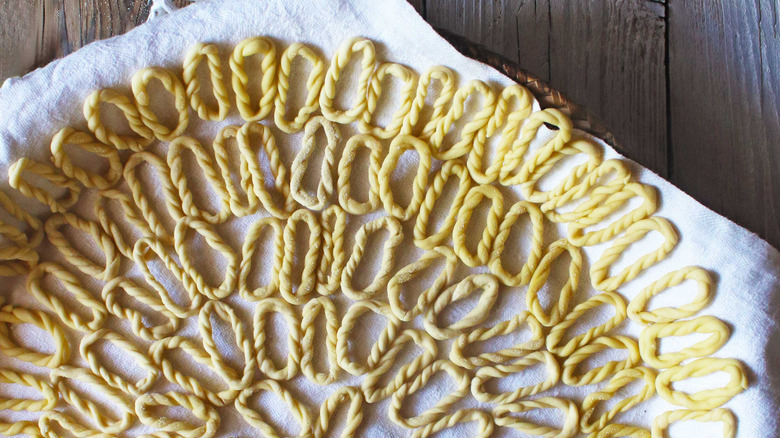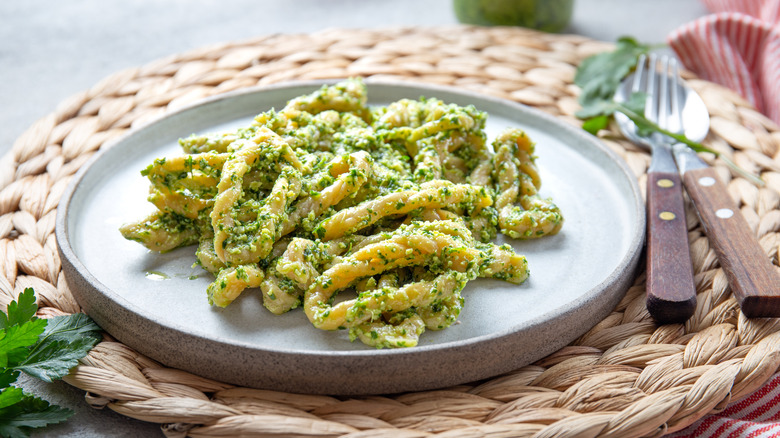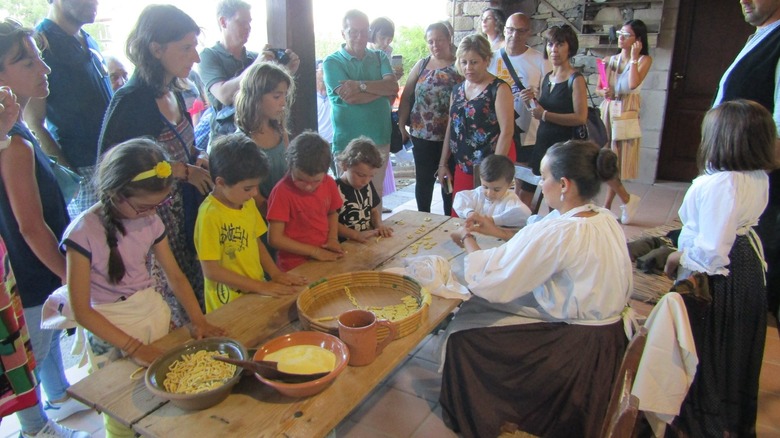The Pasta So Unique People Train For Years To Master Its Shape
Off the coast of Italy is a mountainous Mediterranean island with sandy beaches, crystal clear water, and incredible food: Sardinia. Culinarily, the island is known for mutton, honey, cheese, and its durum wheat semolina, which gets made into bread and pasta. Sardinian pasta is often detailed, somewhat painstaking to make, and quite unique. These pasta varieties include ladittas, which are flat disks indented with the thumb; delicate, twisted spirals called andarinos; needle-thin long-stranded pasta called filindeu; malloreddus, a gnocchi-shaped, ribbed and rolled pasta; and little Israeli couscous-like semolina pasta balls that get toasted in the oven called fregula. Then, there are lorighittas.
Lorighittas are made by wrapping a long rope of pasta into a circle twice around, pinching the ring together, and rolling the strands over themselves to create twists. This is one pasta that absolutely must be made by hand, as machines can't replicate and mass produce it like they can with more common shapes like gemelli or fusilli. And it's a cultural phenomenon that Sardinians take very seriously.
Pasta you have to work for
In order to master the process, the people who make this pasta train for years, and there are very few who do it, as reported by BBC. It takes quite a bit of dexterity to shape them. As a pastoral society, women were generally in charge of food preparation, which is why so many of the lorighitta makers were, and remain, women. It's said that this task often fell to unmarried young women who would make the pasta, set it out to dry, and then don them as earrings. The name lorighittas has a few speculative origin stories but the name comes from a loose translation of either "ears" or "iron ring."
The process of making lorighittas is so intricate that it can take up to a full day to make one pound of pasta. Traditionally, they were made once per year for a feast in the mountain town of Morgongiori to celebrate All Saints Day on the first of November. Now, they're served in some Sardinian restaurants to preserve and honor the history of the Sardinian specialty.
A celebrated pasta shape
The first recorded history of the pasta shape dates back to the 1500s in a report made to the King of Spain (Sardinia was, at the time, under Spanish rule), but there's a good chance that lorighittas date well back beyond that. Sardinia, an island with Italian, Roman, Spanish, African, and French influences in its cultural foodways, has different specialties for every village. In an effort to preserve this history after it began to wane with the addition of supermarkets on the island, the Morgongiori town council founded the Sagra Delle Lorighittas, a festival celebrating the intricate pasta, in 1994.
The festival takes place on the first weekend in August every year. It celebrates the pasta, but it also shines a spotlight on those who make it. Last year, the Sagre Delle Lorighittas was combined with the Dromos Jazz Festival, introducing music and further merriment to the event. Though the festival has not been announced yet for this year, there's little reason to believe it won't continue — last year's festival ended with a promise to be back in 2023 to promote the culture, traditions, history, economy of the Morgongiori community, and, of course, the lorighitta.


